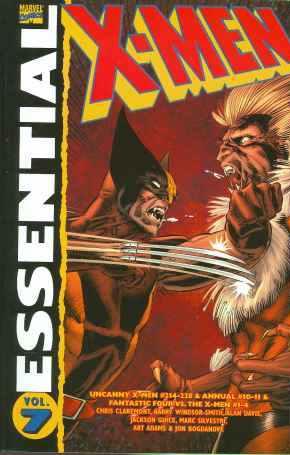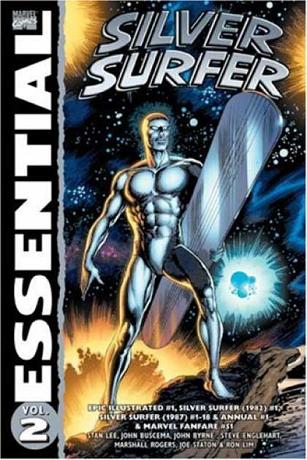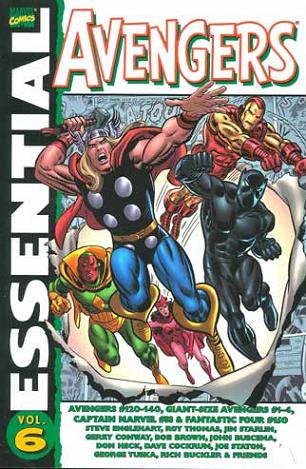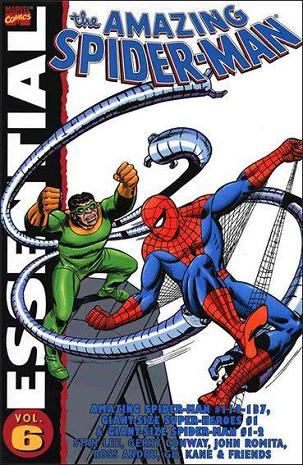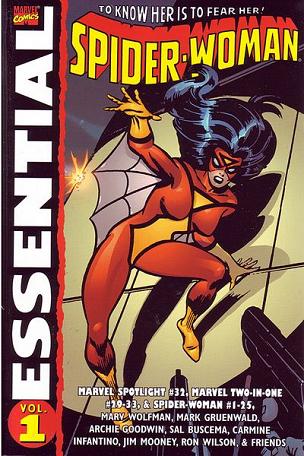
Essential Spider-Woman Vol. 01
Marv Wolfman, Mark Gruenwald, Michael Fleisher, Carmine Infantino and friends
Reprints: Marvel Spotlight #32, Marvel Two-in-One #29-33, Spider-Woman #1-25 (February 1977 – April 1980)
Get this for: quite good for a trademark grab — four stars
Spider-Woman, like fellow late seventies heroes Ms. Marvel and She-Hulk is one of those superheroes who you suspect to have only been created only to safeguard a trademark. This may be a bit too cynical and certainly her solo series was actually quite good, if suffering from some of the usual defects common to series with a female lead. One point that worked in her favour from the start is that she might share her name with Spider-Man, neither her powers nor herself were related to him; she was more than a weak copy of him. She managed a quite respectable run on her series, fifty issues and Essential Spider-Woman Vol. 1 collects half of it, as well as her first appearances in Marvel Spotlight #33 and Marvel Two-in-One #29-33.
Spider-Woman was created by Archie Goodwin and Sal Buscema, but it was Marv Wolfman who guided her through her early days, first in Marvel Two-in-One and the first eight issues of her own title. He makes her into Jessica Drew, a somewhat confused young woman, with barely any knowledge of her own past, which is explained by her having been in suspended animation for years, having almost died from radiation poisoning and been injected with a spider venom serum to save her. For the first two issues of her solo series she still runs around in England, where she was left after having teamed up with the Thing in Marvel Two-in-One, but from the third Wolfman relocates her in L.A., far away enough from other superheroes to not let them crowd her style.
Something a SHIELD agent supporting cast member by the name of Jerry Hunt does enough already, playing the clinging love interest disapproving of Jessica’s activities as Spider-Woman. He sticks around for about sixteen issues, though less and less so even when Wolfman was still writing it. He’s just annoying and dull and like Magnus, the mysterious older magician gentleman also hanging around Jessica, he takes away some of her lustre. Another thing that hampers her appeal in these early issues is how often Spider-Woman has to play the victim: be knocked out, tied up and having to be rescued by others, compared to what male heroes go through. Once Mark Gruenwald and later Michael Fleisher took over, this fortunately happened much less.
Villainwise Spider-Woman has a reasonable rogues gallery here, mainly with brandnew villains like the Brothers Grimm, the Hangman and the Needle, the Gypsy Moth, not to mention Morgain Le Fay, who would become her personal nemesis. Her villains tend to be either somewhat on the grotesque side like the lot I just mentioned, or more mundane gangsters and crooks. The latter start to dominate once Spider-Woman starts her career as a bounty hunter. Few already established villains paid a visit to Spider-Woman, the most important one being Nekra, the old Steve Gerber Daredevil villain, who hoped to use Spider-Woman’s powers for herself.
The stories are fairly simple, with few subplots. Characterisation changes a lot between writers, Marv Wolfman having established her as being sexually alluring to men but hideous to women, which Gruenwald did away with by getting her a special medicine that suppressed the pheremones that supposedly had this effect.
On the art front, the series starts with Carmine Infantino, who’s a long way down from his sixties DC heights, but still a consumate professional. There are a few fillins by Frank Springer and Trevor von Eeden as well, none very good. Sadly the best art is in the last issue presented here, by Steve Leialoha, whose fluid, stylised Michael Goldenesque art style works well with Spider-Woman.
Essential Spider-Woman Vol. 01 is a decent collection of stories, none of which really set the world on fire when first published and with the best of her series yet to come.
